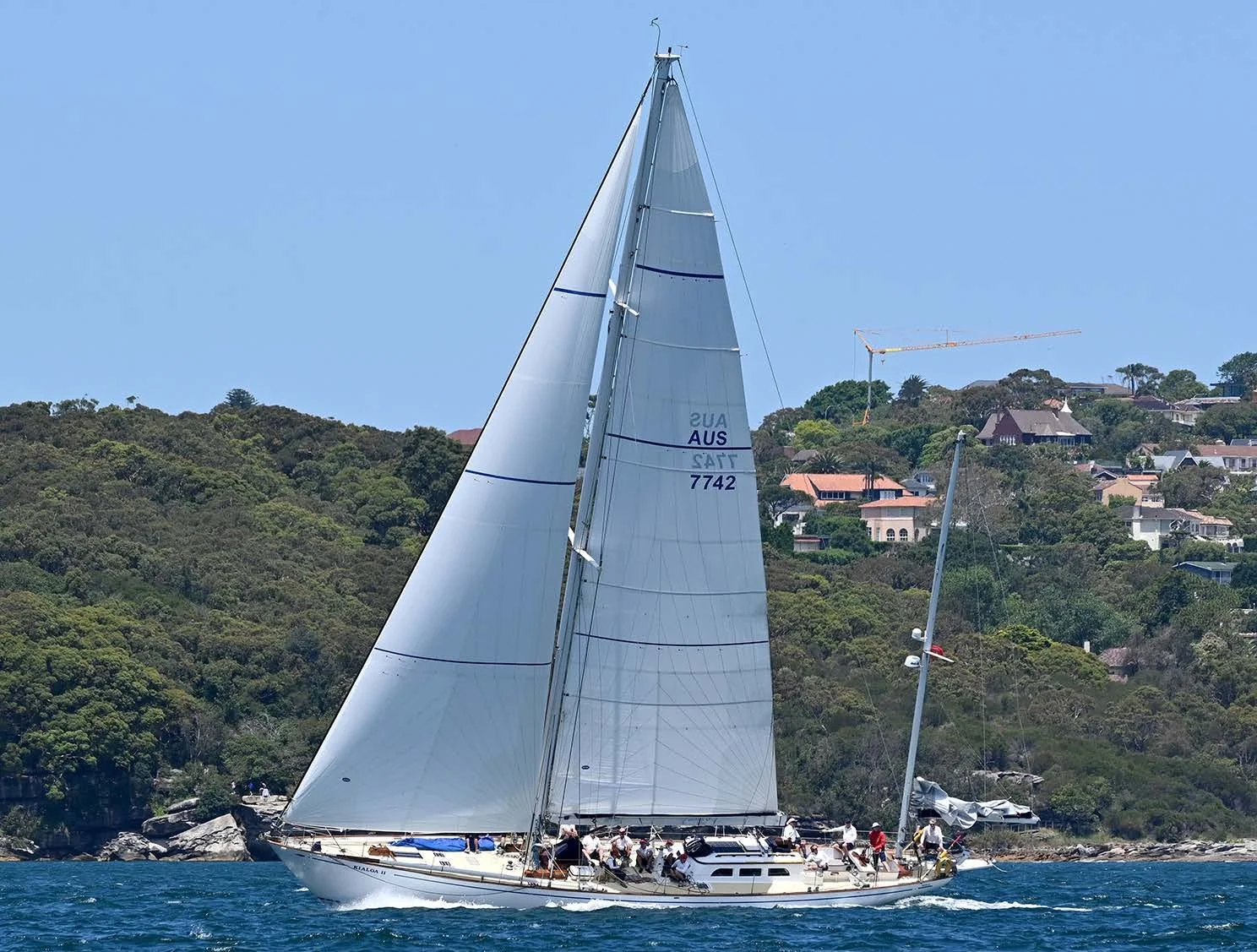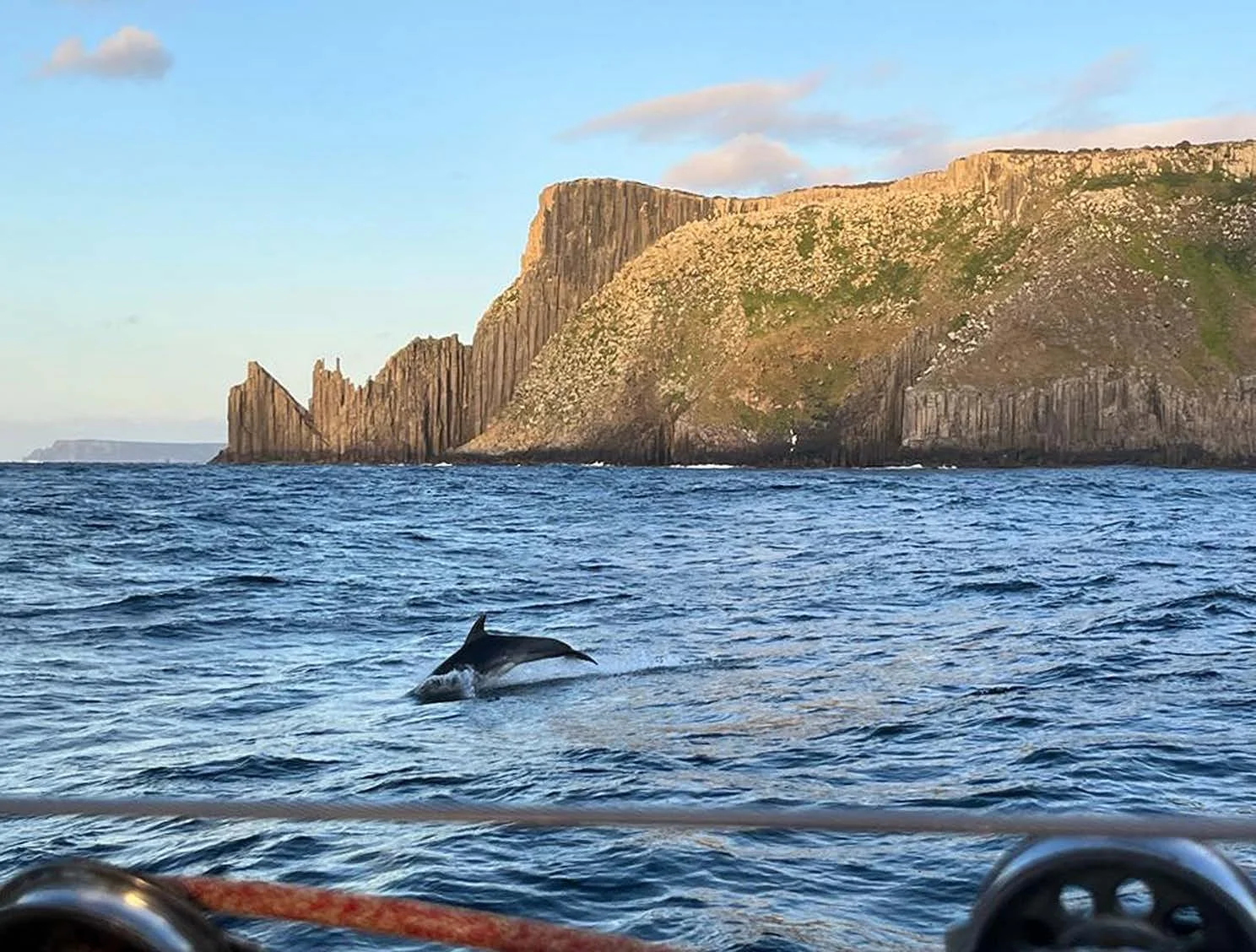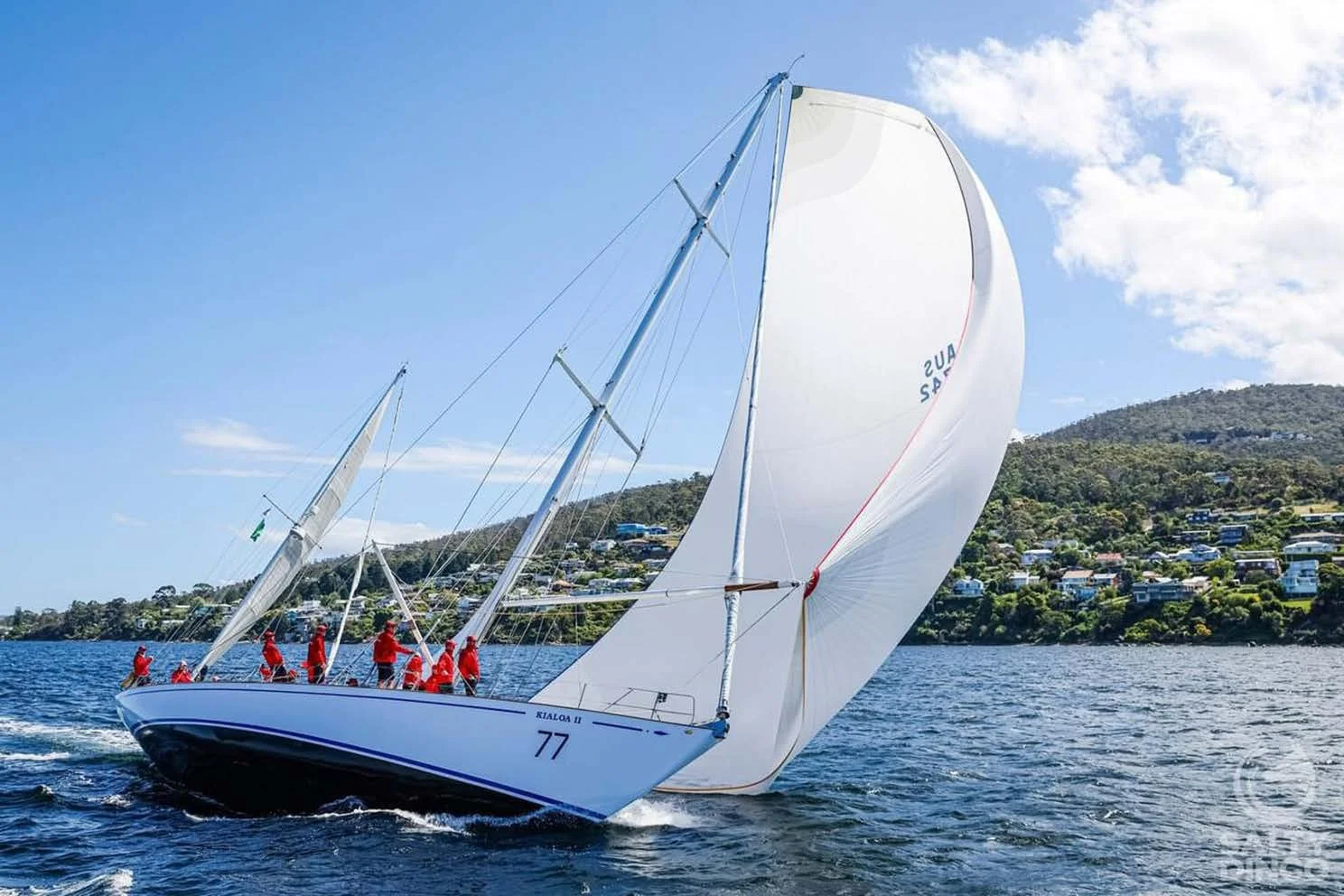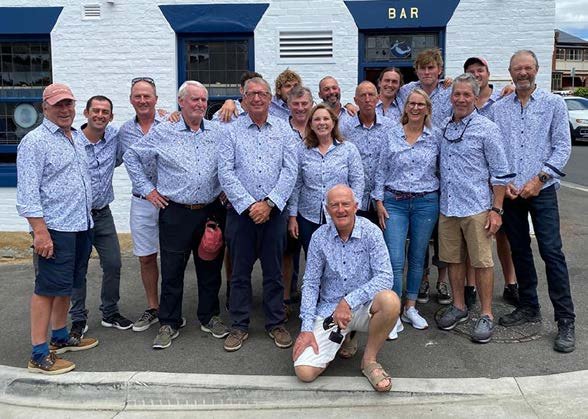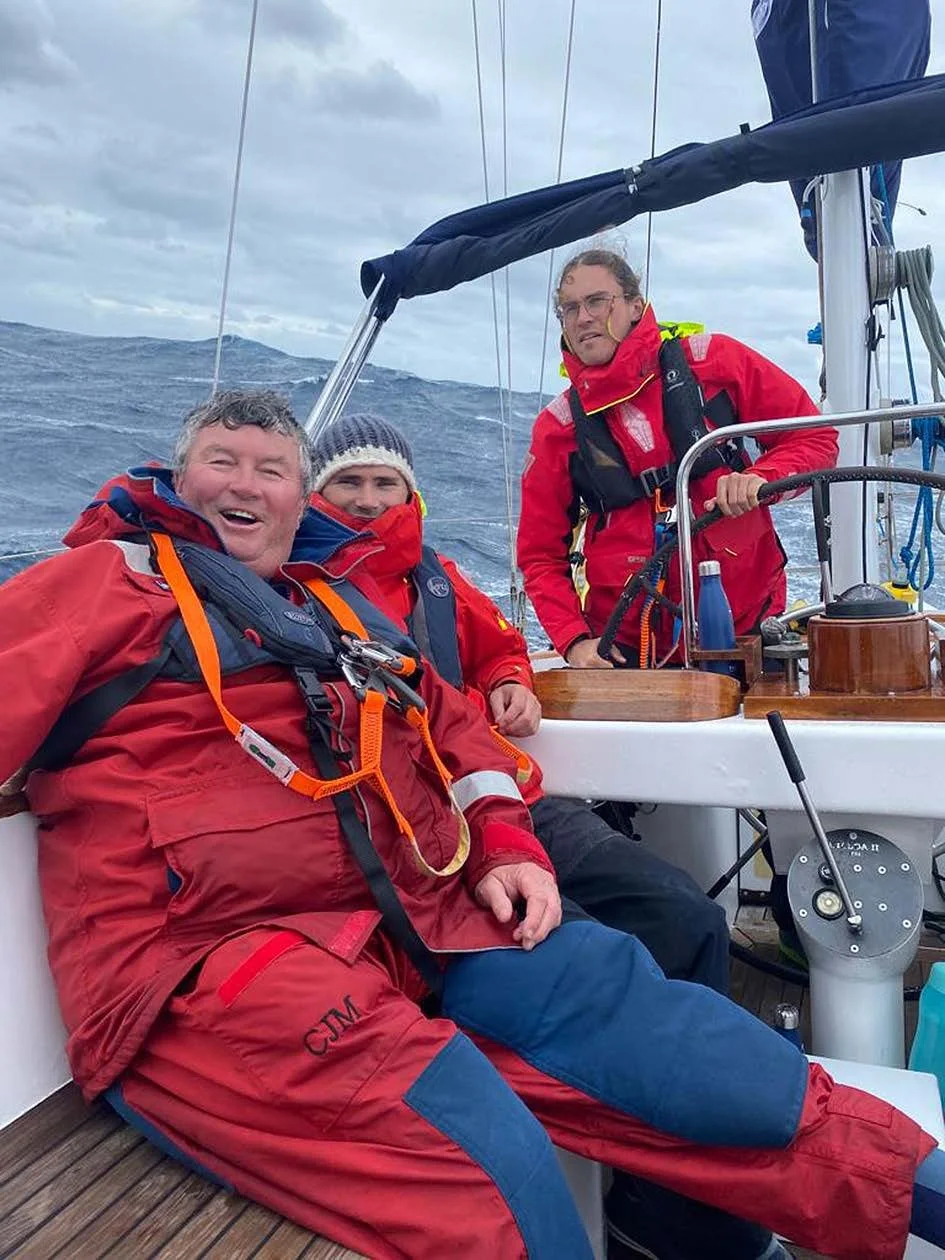To Hobart aboard KIALOA II
By Tim Manion
Readers may recall Herschel Smith’s article in the February edition of SASC News — a tale of four gentlemen on a gentleman’s cruise to Lord Howe Island for the 20th BBQ last November. I won’t recount much of that return voyage except to say that if you had asked me at the 11th hour (out of a total of 36 hours spent lying ahull in a confused Tasman) if I was interested in going offshore again in 2022, the answer would have been an emphatic no.
KIALOA II sailing in the Sydney- Hobart Classics Regatta last December-Photo John Jeremy
However, spending six days aboard Double Dutch beating/floating into a westerly must have unfortunately stirred the deep masochistic pull of offshore sailing and only seven days later I found myself suited up with the opportunity to race with Kialoa II to Cabbage Tree Island. What followed was champagne sailing. Coming out of Sydney Harbour under the full wardrobe (reaching conditions with the jib, staysail, main, mizzen staysail and mizzen main), followed by a lightning fast reach all the way to Cabbage Tree and back with no swell and clear skies. This offshore business is easy! Somewhere off Terrigal I was also provided an opportunity (at the expense of a patient) to flex my day job in the Emergency Department and put six stitches in the navigator’s leg. A ride to Hobart was offered in lieu of remuneration.
Kialoa II is a true beauty, initially designed as a sloop in 1963 by Sparkman & Stephens for the American yachtsman Jim Kilroy as a part of the decade’s long Kialoa program. A defining feature of Kialoa II was her aluminium construction, a significant step away from the typically wooden construction of her rivals at the time. At 73 ft long, she was one of the first purpose-built ocean racing maxis and toured the globe winning most major ocean races at least once, the most notable of these was perhaps the 1965 Transpac line honours in nine days and 19 hours. After being converted in 1968 to her current yawl configuration, she came to Australia for a single Sydney to Hobart start — a reportedly gruelling upwind race in 1971, taking line honours in three days, 12 hours and 46 minutes.
Jim Kilroy donated Kialoa II to the US Coast Guard in 1973 as he moved his attention towards Kialoa III (the yacht that went on to set the Hobart speed record which stood for 21 years). Kialoa II remained a training vessel until 1978 when she was sold to private owners and maintained as a cruising vessel for close to 40 years.
Her current owners, Paddy and Keith Broughton, bought the yacht in Europe in 2016 with a plan to return her to former racing glory and compete in the classic ocean races as she did under Kilroy. This included maintaining systems as close to original as possible with only two concessions — modern instruments and modern sail technology. They have done a truly incredible job with what was essentially a complete refurbishment of the standing and running rigging, and have since completed the Fastnet, Transpac, and multiple Sydney to Hobarts — beating Kilroy’s time of three days 12 hours on each occasion.
Photo John Jeremy
And so, after some further racing in the Sydney to Hobart Classic Yacht Regatta and a few extra training days thrown in, it comes to Boxing Day. A stunning Sydney day with a moderate NE sea breeze and sun for the flotilla of spectators. After an exhausting beat up out of the harbour for us winch monkeys (yes that original technology includes 60-year-old coffee grinders connected to the primaries via a horizontally-laid bike chain — not the most efficient) it was time to pop the kite and rip down the coast. Things remained fairly uneventful for the following 36 hours, as the northerlies continued to build down past Gabo and into the paddock.
What followed was some exciting downwind sailing. With wind speeds of up to 45 knots from behind, simple manoeuvres became all 18 hands on deck and up to 45 minutes of planning and execution just to safely gybe the 45-ton bucking bronco. As seas picked up through Bass Strait a number of helmsmen began to set new boat speed records for Kialoa II (previously at 17 knots) — much to the chagrin of the off-watch owner Paddy. Adding to Paddy’s woes was the third (!) blocked head of the race, which, to his utter credit, was immediately addressed with none of the cursing or carry-on that it probably deserved.
This was all soon to change on the following watch. Unsatisfied with boat speeds of 20 to 21knots, (given the new record is set at 21.7 knots) the skipper lines himself up and holds on with white knuckles as Kialoa II charges down a wave. 23 knots! With a poled-out yankee and a reefed main! The crew rejoices.
Storm Bay jib repairs with Cape Raoul in the background-Photo Tim Manion
Rounding Tasman Island at dawn
With the northerly carrying us across the strait, all attention was on how to address the southerly change expected on the NE coast of Tasmania. Unfortunately for Kialoa II this meant a big soft patch and around two hours of searching for breeze on the afternoon of the 28th. As the front pushed through we didn’t have to look any further as we entered a long night of upwind slogging. There was plenty of work to do in a breeze that was shifting between 20 to high-30 knots on the nose — leading to calls of reef-in, reef-out, reef-in, second reef-in, second reef-out, both reefs out, one reef back in… and so on.
All was forgotten by morning as we were treated to a dawn rounding of Tasman Island, abating winds, a couple of dolphins and maybe even a Bloody Mary (courtesy of the cook Dani Blackmore who kept the entire crew satiated and hydrated throughout). A frustrating morning through Storm Bay was punctuated by some urgent repairs to the new No.1 off Cape Raoul.
Finally rounding the Iron Pot in the early afternoon, we were able to pop the kite and scream up the Derwent on a great fun shy reach. As we approached John Garrow Light it became apparent we may have bitten off a little more than Kialoa II could chew. With the E/NE winds taking us further left, Keith Broughton on the helm pushed the boat to its absolute limit with serious concerns about the safety of the kite and the rigging being shared amongst the bow team. Adding to the excitement was the media boat and a number of spectators in close proximity.
A shy reach at the limit to make it around John Garrow Light Photo- Salty Dog
With some great steering aided by expert trim from Chris Harmsen, the rounding was made and Kialoa II was home and hosed. A 4 pm finish not only meant a new course record for Kialoa II of three days, three hours and 15 minutes, but also a primetime drive-by of the Taste of Tasmania festival. The reception in Hobart is legendary and we were not disappointed.
Nothing much happened over the next few days in Hobart... There was a quiet crew lunch at Shippies with a few awards — the Rolex tie going to the Most-Valuable-Player Sandy McWilliams, and the presentation of the preventer pad eye that was ripped out the boom in a certain unintended manoeuvre going to helmsman Rowdy McCullum.
Crew lunch at the legendary Shipwrights Arms Hotel
Another highlight was sharing our arm of the marina with the gaff-rigged beauty Maluka, skippered by Peter Langman to a division win, and another classic S&S 34 Azzurro with Shane Kearns and crew. It was also particularly special to be alongside Currawong, the Currawong 30 sailed two-handed by Kathy Veel and Bridget Canham into Constitution Dock as the midnight fireworks exploded overhead.
On 1 January we were joined by SASC Rear Commodore Chris Manion who joined us for the return delivery which departed on the 2nd. A skeleton crew of eight left at mid-morning, and it soon became apparent that our idyllic delivery of sightseeing and paddle-boarding was not to be. A window of three days in which to beat some heavy weather meant that we were racing back to home in Pittwater. Without dropping anchor, we came home in style under storm gear which went up somewhere off Gerringong, and settled the helm down to allow us to smoothly come around Barrenjoey Head in just over three and a half days.
Kialoa II is certainly a yacht put together by the efforts of its crew. Special mention must go to the legendary Lindsay May, prolonging his record for the most consecutive Hobarts which now stands at 49. Aside from those mentioned throughout the article, special effort was put into safety by Genevieve White, and into preparing the boat by Ian Goldsworthy and Andrew Cutler. The crew was rounded out by the expert bow-team of Jeff Beaton, Richie Snow and Paul Runyan, trimmer Dave Cummins, and my three fellow grinders — the brothers Mallee, Aero and Ek Leplastrier-Lambert. Most thanks, of course, go to owners Paddy and Keith Broughton, and the effort of Mel Broughton in wrangling 1 8 c r e w m e m b e r s a n d spearheading the preparation/ shore team of a big crew.
By the time this article goes to print Kialoa II will hopefully be in Antigua racing in the Classic Yacht Regatta, halfway back to the UK to compete in this year’s 50th Fastnet. It is unknown when she’ll be back to Australian shores, if ever, leaving a bittersweet taste for this historic yacht’s second wind as a racing machine.

